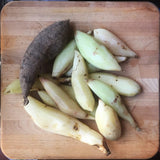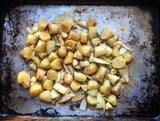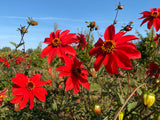Cocoxochitl (Culinary Dahlias)
Dahlia spp.
Dahlias make edible flowers and tubers and are a traditional Aztec food crop called Cocoxochitl in the Nahuatl language.
These dahlia seeds came from initial selections from a planting of thousands of dahlias. Seeds were selected from sturdy plants that did not fall over, that were not lanky or overly dense, and that had petals that tasted nice. The original seeds came from several sources who had been selecting for tuber flavor and productivity. Because these are still in the early stages of selection, and because dahlias are extremely variable when grown from seed, not all of the offspring of these seeds will be particularly delicious or large, though the hope is that this population will be more delicious and more productive so that you could eat well and do your own selecting. This population tends toward having single, scarlet, wild-type blooms.
If you can read Spanish, consider the recipes offered by Asociación Mexicana de la Dalia o Acocoxochitl, A.C.: HERE
Following are some much abbreviated recipe ideas we translated from “Recetario Flores de Dalia”, a publication from the same group. First clean the tubers, remove the small roots, boil them for 30-45 minutes, and peel off their skin. From there, you have several options: you can make cubes and add them to carrots and peas in a rice dish; cut and fry them like French fries; add milk, butter, salt, and pepper and puree them like mashed potatoes; or add them to a puree of eggplant and tomatoes, Middle Eastern style.
For older, more traditional uses, you can cook cubed dahlias in honey and cinnamon. For a savory pancake, mix dahlia petals, cooked and chopped quelites (wild spinach), eggs (turkey or chicken), flour, grated cheese, and salt, make into patties, and fry in oil. You can also place the tubers in the middle of agave leaves (or alone) and cook in embers for an hour and eat with a little salt.
Days to mature tubers: 120
Seeds per pack: 40
Germination rate: 93% on 05/16/2025
Planting / harvesting notes
Start the seeds in a moist potting soil mix, lightly cover them, and keep them moderately moist and warm. Germination should take 7-12 days. When the starts are about an inch tall, pot them up into 3" pots. Transplant them in the garden when they have filled in their pots and after the last danger of frost. Space plants in garden by 18-24". Trellis or stake as the plant grows tall. After the first frost in the fall, cut back the plant to 1-3" above the base of the plant. Lift the tubers carefully and gently (they can spread up to 12" in each direction under the soil). Gently shake off the soil and allow to cure in a cool, ventilated place for a week or so. Cut off broken-necked tubers and small root hairs. We simply store ours in a labeled paper bag, within a cardboard box in a cool, dry basement until spring!
Seed keeping notes
Allow the flowers to die back until brown and crispy. Cut the seed pod (spent flower) at the base and allow it to dry in a dry, ventilated place for another couple weeks. Separate the elongated, plump, black seeds from the papery spent flowers petals. Allow the seeds to dry on a paper towel, sheet, or paper bag in a dry, ventilated place for another week or two before storage.













